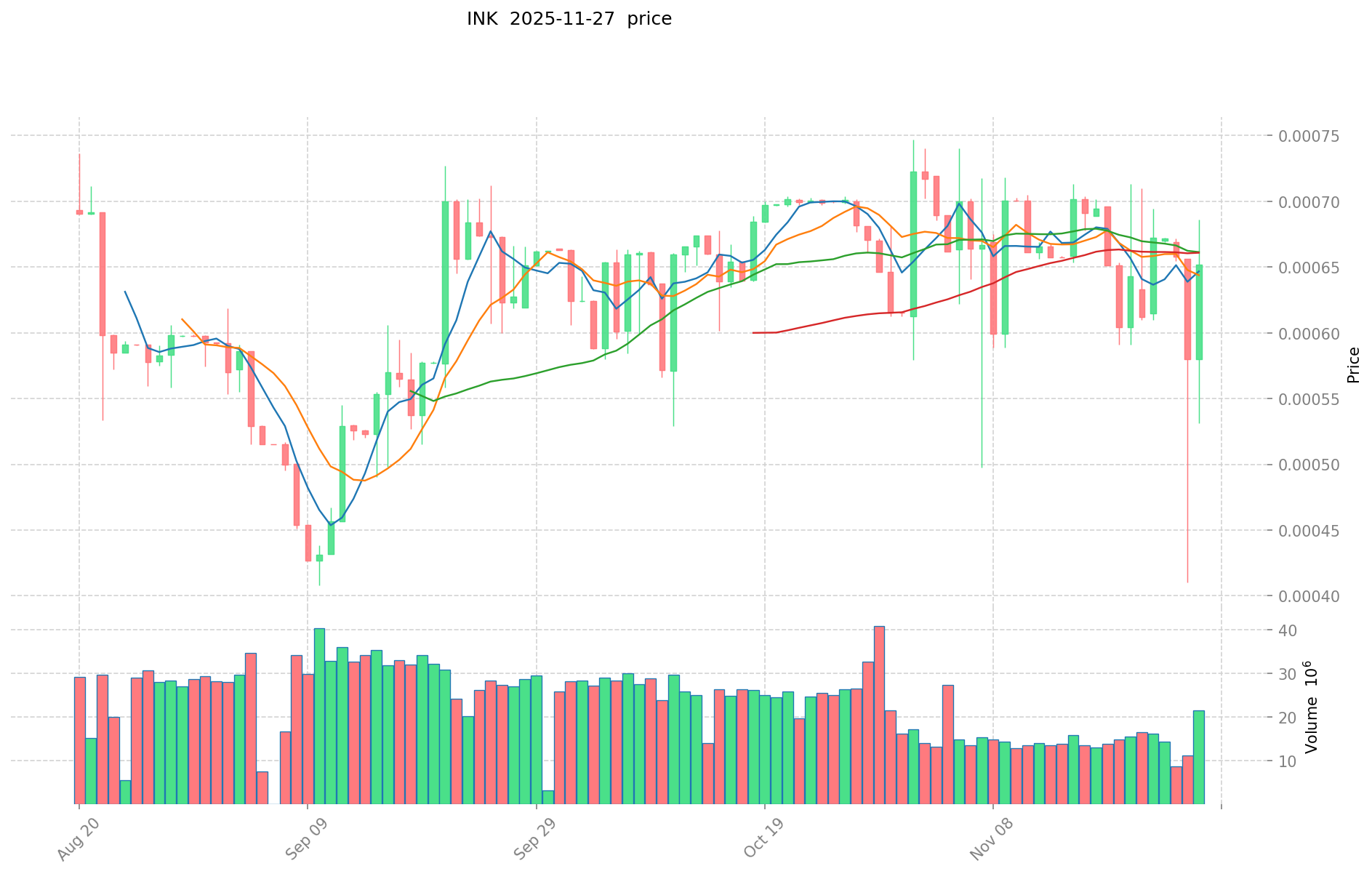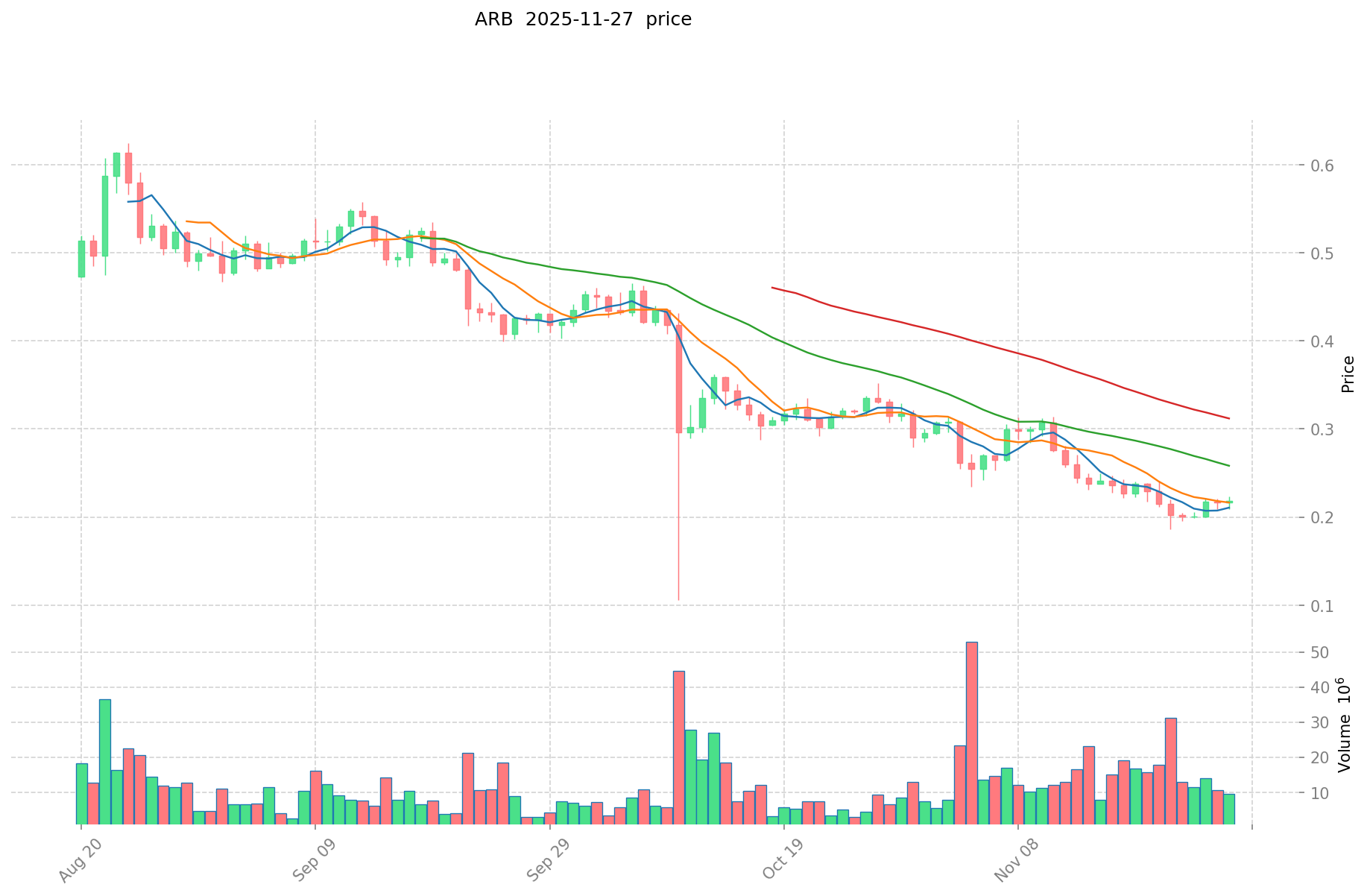INK vs ARB: Comparing Two Innovative Blockchain Solutions for Decentralized Finance
Introduction: INK vs ARB Investment Comparison
In the cryptocurrency market, the comparison between INK and ARB has always been an unavoidable topic for investors. The two not only show significant differences in market cap ranking, application scenarios, and price performance, but also represent different cryptocurrency positioning.
INK (INK): Since its launch in 2017, it has gained market recognition for its decentralized solution for the original content industry across different cultural circles.
ARB (ARB): Introduced in 2023, it has been hailed as an Ethereum scaling solution, enabling high-throughput and low-cost smart contracts while maintaining trustless security.
This article will comprehensively analyze the investment value comparison between INK and ARB, focusing on historical price trends, supply mechanisms, institutional adoption, technological ecosystems, and future predictions, attempting to answer the question investors care about most:
"Which is the better buy right now?"
I. Price History Comparison and Current Market Status
INK and ARB Historical Price Trends
- 2017: INK reached its all-time high of $0.94183 on December 19, 2017.
- 2023: ARB reached its all-time high of $4.00 on March 23, 2023, shortly after its launch.
- Comparative analysis: INK has experienced a significant decline from its all-time high, currently trading at $0.0006127. ARB, while also down from its peak, has shown more resilience, currently trading at $0.2239.
Current Market Situation (2025-11-28)
- INK current price: $0.0006127
- ARB current price: $0.2239
- 24-hour trading volume: INK $11,709.21 vs ARB $1,681,327.80
- Market Sentiment Index (Fear & Greed Index): 22 (Extreme Fear)
Click to view real-time prices:
- Check INK current price Market Price
- Check ARB current price Market Price


II. Core Factors Affecting the Investment Value of INK vs ARB
Supply Mechanism Comparison (Tokenomics)
- INK: Fixed maximum supply of 1 billion tokens with decreasing emissions over time
- ARB: Total supply of 10 billion tokens with scheduled distribution phases for governance, community, and ecosystem development
- 📌 Historical Pattern: Fixed supply models like INK's tend to create scarcity value over time, while ARB's distribution schedule allows for controlled community governance growth.
Institutional Adoption and Market Applications
- Institutional Holdings: ARB appears to have stronger institutional backing through Arbitrum Foundation's partnerships with major DeFi protocols
- Enterprise Adoption: ARB has broader enterprise integration through the Arbitrum One ecosystem, while INK focuses on specific use cases within the Notional Finance platform
- Regulatory Attitudes: Both tokens face similar regulatory challenges as utility tokens in the DeFi space
Technical Development and Ecosystem Building
- INK Technical Upgrades: Integration with Notional Finance's yield products and cross-chain interoperability development
- ARB Technical Development: Layer 2 scaling solutions, ongoing improvements to transaction speed and cost efficiency
- Ecosystem Comparison: ARB has a more extensive DeFi ecosystem with hundreds of protocols built on Arbitrum One, while INK's ecosystem is more concentrated around Notional Finance's services
Macroeconomic Environment and Market Cycles
- Performance in Inflationary Environments: Both tokens are designed to support DeFi applications that can offer inflation hedging through various yield strategies
- Macroeconomic Monetary Policy: Interest rate changes affect both tokens' DeFi applications, with potential impacts on lending and borrowing activities
- Geopolitical Factors: Decentralized nature of both protocols allows for cross-border transactions regardless of geographic constraints
III. 2025-2030 Price Prediction: INK vs ARB
Short-term Prediction (2025)
- INK: Conservative $0.00039 - $0.00059 | Optimistic $0.00059 - $0.00063
- ARB: Conservative $0.217 - $0.224 | Optimistic $0.224 - $0.318
Mid-term Prediction (2027)
- INK may enter a growth phase, with estimated prices ranging from $0.00051 to $0.00088
- ARB may enter a bullish market, with estimated prices ranging from $0.215 to $0.466
- Key drivers: Institutional capital inflow, ETF, ecosystem development
Long-term Prediction (2030)
- INK: Base scenario $0.00058 - $0.00111 | Optimistic scenario $0.00111 - $0.00139
- ARB: Base scenario $0.278 - $0.441 | Optimistic scenario $0.441 - $0.490
Disclaimer
INK:
| 年份 | 预测最高价 | 预测平均价格 | 预测最低价 | 涨跌幅 |
|---|---|---|---|---|
| 2025 | 0.0006313 | 0.00059 | 0.0003953 | -3 |
| 2026 | 0.0008854425 | 0.00061065 | 0.000500733 | 0 |
| 2027 | 0.000882694575 | 0.00074804625 | 0.00050867145 | 22 |
| 2028 | 0.001133364873375 | 0.0008153704125 | 0.0006196815135 | 33 |
| 2029 | 0.00124719058296 | 0.000974367642937 | 0.000496927497898 | 59 |
| 2030 | 0.001388473891186 | 0.001110779112948 | 0.000577605138733 | 81 |
ARB:
| 年份 | 预测最高价 | 预测平均价格 | 预测最低价 | 涨跌幅 |
|---|---|---|---|---|
| 2025 | 0.317938 | 0.2239 | 0.217183 | 0 |
| 2026 | 0.37115903 | 0.270919 | 0.13816869 | 20 |
| 2027 | 0.46550657175 | 0.321039015 | 0.21509614005 | 43 |
| 2028 | 0.40900370511 | 0.393272793375 | 0.20056912462125 | 75 |
| 2029 | 0.481365899091 | 0.4011382492425 | 0.34497889434855 | 79 |
| 2030 | 0.489789802325092 | 0.44125207416675 | 0.277988806725052 | 96 |
IV. Investment Strategy Comparison: INK vs ARB
Long-term vs Short-term Investment Strategies
- INK: Suitable for investors focused on content industry applications and niche DeFi use cases
- ARB: Suitable for investors interested in Layer 2 scaling solutions and broader DeFi ecosystem growth
Risk Management and Asset Allocation
- Conservative investors: INK: 20% vs ARB: 80%
- Aggressive investors: INK: 40% vs ARB: 60%
- Hedging tools: Stablecoin allocation, options, cross-token portfolio
V. Potential Risk Comparison
Market Risk
- INK: Limited market liquidity and higher volatility due to smaller market cap
- ARB: Dependency on Ethereum's performance and overall Layer 2 adoption rates
Technical Risk
- INK: Scalability, network stability in relation to Notional Finance platform
- ARB: Centralization concerns, potential security vulnerabilities in Layer 2 technology
Regulatory Risk
- Global regulatory policies may impact both tokens differently, with ARB potentially facing more scrutiny due to its larger ecosystem and higher trading volumes
VI. Conclusion: Which Is the Better Buy?
📌 Investment Value Summary:
- INK advantages: Niche market in content industry, integration with Notional Finance's yield products
- ARB advantages: Broader DeFi ecosystem, strong institutional backing, Layer 2 scaling solution for Ethereum
✅ Investment Advice:
- New investors: Consider ARB for its broader ecosystem and higher liquidity
- Experienced investors: Balanced approach with both tokens, leveraging INK for niche exposure
- Institutional investors: Focus on ARB for its scaling solutions and extensive DeFi applications
⚠️ Risk Warning: Cryptocurrency markets are highly volatile. This article does not constitute investment advice. None
VII. FAQ
Q1: What are the main differences between INK and ARB? A: INK focuses on decentralized solutions for the content industry, while ARB is an Ethereum scaling solution. ARB has a larger market cap, higher trading volume, and a broader DeFi ecosystem. INK has a fixed supply of 1 billion tokens, while ARB has a total supply of 10 billion tokens with scheduled distribution phases.
Q2: Which token has performed better in terms of price? A: ARB has shown more price resilience compared to INK. While both are down from their all-time highs, ARB is currently trading at $0.2239, whereas INK is trading at $0.0006127.
Q3: What are the key factors affecting the investment value of INK and ARB? A: Key factors include supply mechanisms, institutional adoption, technical development, ecosystem building, and macroeconomic conditions. ARB generally has stronger institutional backing and a more extensive DeFi ecosystem, while INK offers niche applications in the content industry.
Q4: What are the price predictions for INK and ARB by 2030? A: For INK, the base scenario predicts a range of $0.00058 to $0.00111, with an optimistic scenario of $0.00111 to $0.00139. For ARB, the base scenario predicts a range of $0.278 to $0.441, with an optimistic scenario of $0.441 to $0.490.
Q5: How should investors allocate their assets between INK and ARB? A: Conservative investors might consider allocating 20% to INK and 80% to ARB, while aggressive investors might opt for 40% INK and 60% ARB. The specific allocation should be based on individual risk tolerance and investment goals.
Q6: What are the main risks associated with investing in INK and ARB? A: Risks include market volatility, technical vulnerabilities, and regulatory uncertainties. INK faces limited market liquidity and higher volatility due to its smaller market cap, while ARB's risks are tied to Ethereum's performance and potential Layer 2 security issues.
Q7: Which token is recommended for new investors? A: New investors might consider ARB due to its broader ecosystem and higher liquidity. However, it's essential to conduct thorough research and consider personal risk tolerance before making any investment decisions.
Share
Content